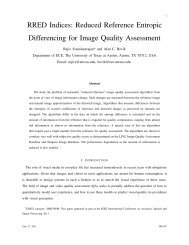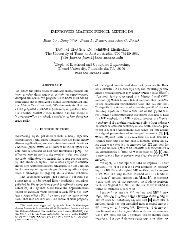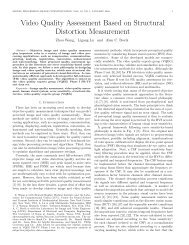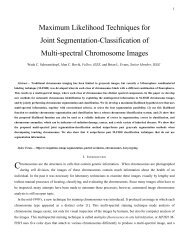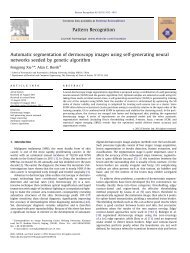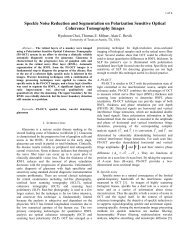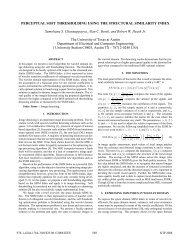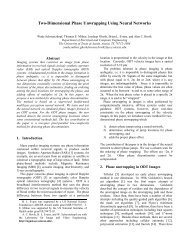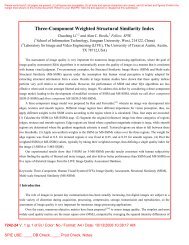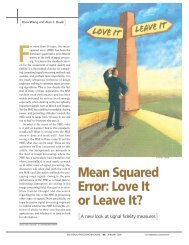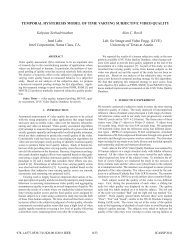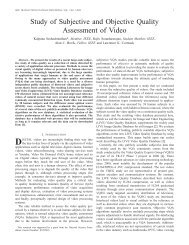Quality Assessment of Deblocked Images - Laboratory for Image ...
Quality Assessment of Deblocked Images - Laboratory for Image ...
Quality Assessment of Deblocked Images - Laboratory for Image ...
Create successful ePaper yourself
Turn your PDF publications into a flip-book with our unique Google optimized e-Paper software.
88 IEEE TRANSACTIONS ON IMAGE PROCESSING, VOL. 20, NO. 1, JANUARY 2011<br />
<strong>Quality</strong> <strong>Assessment</strong> <strong>of</strong> <strong>Deblocked</strong> <strong><strong>Image</strong>s</strong><br />
Changhoon Yim, Member, IEEE, and Alan Conrad Bovik, Fellow, IEEE<br />
Abstract—We study the efficiency <strong>of</strong> deblocking algorithms<br />
<strong>for</strong> improving visual signals degraded by blocking artifacts from<br />
compression. Rather than using only the perceptually questionable<br />
PSNR, we instead propose a block-sensitive index, named<br />
PSNR-B, that produces objective judgments that accord with<br />
observations. The PSNR-B modifies PSNR by including a blocking<br />
effect factor. We also use the perceptually significant SSIM index,<br />
which produces results largely in agreement with PSNR-B. Simulation<br />
results show that the PSNR-B results in better per<strong>for</strong>mance<br />
<strong>for</strong> quality assessment <strong>of</strong> deblocked images than PSNR and a<br />
well-known blockiness-specific index.<br />
Index Terms—Blocking effect, deblocking, distortion, image<br />
quality assessment, quantization.<br />
I. INTRODUCTION<br />
B<br />
LOCKING effects are common in block-based image and<br />
video compression systems. Blocking artifacts are more<br />
serious at low bit rates, where network bandwidths are limited.<br />
Significant research has been done on blocking artifact reduction<br />
[7]–[14]. Most blocking artifact reduction methods assume<br />
that the distorted image contains noticeable amount <strong>of</strong><br />
blocking. The degree <strong>of</strong> blocking depends upon several parameters,<br />
the most important <strong>of</strong> which is the quantization step <strong>for</strong><br />
lossy compression. Little research has done on comparing the<br />
perceptual quality <strong>of</strong> deblocked images. The recent advent <strong>of</strong><br />
powerful modern image quality assessment (IQA) algorithms<br />
[1]–[5] that compare well with human subjectively makes this<br />
plausible. Here we investigate quality assessment <strong>of</strong> deblocked<br />
images, and in particular we study the effects <strong>of</strong> the quantization<br />
step <strong>of</strong> the measured quality <strong>of</strong> deblocked images. A deblocking<br />
filter can improve image quality in some aspects, but can reduce<br />
image quality in other regards.<br />
We per<strong>for</strong>m simulations on the quality assessment <strong>of</strong><br />
deblocked images. We first per<strong>for</strong>m simulations using the conventional<br />
peak signal-to-noise ratio (PSNR) quality metric and<br />
a state <strong>of</strong> the art quality index, the structural similarity (SSIM)<br />
[1] index. The PSNR does not capture subjective quality well<br />
when blocking artifacts are present. The SSIM metric is slightly<br />
Manuscript received October 27, 2008; revised June 01, 2009; accepted<br />
July 16, 2010. Date <strong>of</strong> publication August 03, 2010; date <strong>of</strong> current version<br />
December 17, 2010. This work was supported by the Konkuk University and<br />
by the Korea Research Foundation Grant funded by the Korean Government<br />
(MOEHRD) (KRF-2008-013-D00083). This work was also supported in<br />
part by the MKE under the ITRC support program supervised by the NIPA<br />
(NIPA-2010-C1090-1031-0003). The associate editor coordinating the review<br />
<strong>of</strong> this manuscript and approving it <strong>for</strong> publication was Dr. Miles N. Wernick.<br />
C. Yim is with the Department <strong>of</strong> Internet and Multimedia Engineering,<br />
Konkuk University, Seoul 143-701, Korea (e-mail: cyim@konkuk.ac.kr).<br />
A. C. Bovik is with the Department <strong>of</strong> Electrical and Computer Engineering,<br />
The University <strong>of</strong> Texas at Austin, Austin, TX 78712 USA (e-mail: bovik@ece.<br />
utexas.edu).<br />
Color versions <strong>of</strong> one or more <strong>of</strong> the figures in this paper are available online<br />
at http://ieeexplore.ieee.org.<br />
Digital Object Identifier 10.1109/TIP.2010.2061859<br />
1057-7149/$26.00 © 2010 IEEE<br />
more complex than the PSNR, but correlates highly with human<br />
subjectively.<br />
We also propose a new deblocking quality index that is sensitive<br />
to blocking artifacts in deblocked images. We name this<br />
peak signal-to-noise ratio including blocking effects (PSNR-B).<br />
The simulation results show that the proposed PSNR-B correlates<br />
well with subjective quality and with the SSIM index, and<br />
per<strong>for</strong>ms much better than the PSNR.<br />
We study a variety <strong>of</strong> image and video deblocking algorithms,<br />
including lowpass filtering, projection onto convex sets<br />
(POCS), and the H.264 in-loop filter. The image improvements<br />
af<strong>for</strong>ded by these algorithms is measured using the PSNR,<br />
PSNR-B, and SSIM. Rather than relying on PSNR, which<br />
correlates poorly with subjective judgment, we utilize PSNR-B<br />
which is designed specifically to assess blocky and deblocked<br />
images (but has no proven perceptual significance) in conjunction<br />
with the SSIM index, which is perceptually significant, but<br />
has not been demonstrated on deblocked images.<br />
Section II reviews the image quality assessment methods we<br />
will consider. In Section III, we consider the relationship between<br />
quantization step size and image quality. Section IV introduces<br />
a distortion change concept to analyze the effects <strong>of</strong><br />
deblocking filters. In Section V, we propose a new deblocking<br />
quality index, PSNR-B. Sections VI and VII present the simulation<br />
results on quality assessment <strong>of</strong> deblocked images and<br />
videos. We present concluding remarks in Section VIII.<br />
II. QUALITY ASSESSMENT<br />
We consider the class <strong>of</strong> quality assessment (QA) methods<br />
that are full-reference (FR) QA, which compares the test (distorted)<br />
image with a reference (original) image. In this paper,<br />
the distorted images will ostensibly suffer from blocking artifacts<br />
or from the residual artifacts following deblocking.<br />
A. PSNR<br />
The simplest and most widely used FR QA metrics are the<br />
peak signal-to-noise ratio (PSNR) and the mean-squared error<br />
(MSE) [1], [3].<br />
Let and represent the vectors <strong>of</strong> reference and test image<br />
signals, respectively. Let be the vector <strong>of</strong> error signal between<br />
and . If the number <strong>of</strong> pixels in an image is , then<br />
MSE (1)<br />
PSNR<br />
(2)<br />
MSE<br />
The PSNR is an attractive QA metric since it is mathematically<br />
simple and has clear physical meaning. However, the<br />
PSNR does not correlate well with perceived visual quality [1],<br />
[3]–[6].
YIM AND BOVIK: QUALITY ASSESSMENT OF DEBLOCKED IMAGES 89<br />
B. SSIM<br />
The structural similarity (SSIM) metric aims to measure<br />
quality by capturing the similarity <strong>of</strong> images [1]. A product <strong>of</strong><br />
three aspects <strong>of</strong> similarity are measured: luminance, contrast,<br />
and structure. The luminance comparison function <strong>for</strong><br />
reference image and test image is defined as<br />
where and are the mean values <strong>of</strong> and , respectively,<br />
and is a stabilizing constant.<br />
The contrast comparison function is defined similarly<br />
as<br />
where and are the standard deviation <strong>of</strong> and , respectively,<br />
and is a stabilizing constant.<br />
The structure comparison function is defined as<br />
where is the correlation between and and is also a<br />
constant that provides stability.<br />
The SSIM index is obtained by combining the three comparison<br />
functions<br />
(3)<br />
(4)<br />
(5)<br />
SSIM (6)<br />
In [1], the parameters are set as and<br />
SSIM (7)<br />
Local SSIM statistics are estimated using a symmetric<br />
Gaussian weighting function. The mean SSIM index pools the<br />
spatial SSIM values to evaluate the overall image quality [1]<br />
SSIM SSIM (8)<br />
where is the number <strong>of</strong> local windows over the image, and<br />
and are image patches covered by the th window.<br />
III. QUANTIZATION STEP SIZE AND IMAGE QUALITY<br />
Quantization is a key element <strong>of</strong> lossy compression, but in<strong>for</strong>mation<br />
is lost. There is a trade<strong>of</strong>f between compression ratio<br />
and reconstructed image/video quality. The amount <strong>of</strong> compression<br />
and the quality can be controlled by the quantization step.<br />
As the quantization step is increased, the compression ratio becomes<br />
larger, and the quality generally worsens. However, there<br />
has not been a study made <strong>of</strong> how perceptual quality suffers as<br />
a function <strong>of</strong> step size, or the degree to which deblocking augments<br />
perceptual quality. The emergence <strong>of</strong> new and powerful<br />
IQA indices suggests this possibility.<br />
In block trans<strong>for</strong>m coding, the input image is divided into<br />
blocks, and each block is trans<strong>for</strong>med independently into<br />
Fig. 1. Block diagram <strong>for</strong> reference, decoded, and deblocked images.<br />
trans<strong>for</strong>m coefficients. An input image block is trans<strong>for</strong>med<br />
into a DCT coefficient block<br />
where is the trans<strong>for</strong>m matrix and is the transpose matrix<br />
<strong>of</strong> . The trans<strong>for</strong>m coefficients are quantized using a scalar<br />
quantizer<br />
(9)<br />
(10)<br />
The quantization operator in (10) is nonlinear, and is a<br />
many-to-one mapping from to [7].<br />
In the decoder, only quantized trans<strong>for</strong>m coefficients are<br />
available. The output <strong>of</strong> the decoder is<br />
(11)<br />
Let represent the quantization step. It is well known that<br />
the PSNR is a monotonically decreasing function <strong>of</strong> .<br />
The SSIM index captures the similarity <strong>of</strong> reference and test<br />
images. As the quantization step size becomes larger, the structural<br />
differences between reference and test image will generally<br />
increase, and in particular the structure term in (5) will<br />
become smaller. Hence, the SSIM index would be a monotonically<br />
decreasing function <strong>of</strong> the quantization step size .<br />
IV. DEBLOCKING FILTER AND DISTORTION CHANGE<br />
As be<strong>for</strong>e, is the reference (original) image and is the<br />
decoded image that has been distorted by quantization errors.<br />
Let represent the deblocked image and represent the deblocking<br />
operation: . Fig. 1 shows a block diagram<br />
depicting the flow <strong>of</strong> reference, decoded, and deblocked images.<br />
Let be the quality metric between and . The goal <strong>of</strong><br />
the deblocking operation is to maximize ,given<br />
image .<br />
Deblocking is a local operation. The deblocking operation<br />
may improve the appearance <strong>of</strong> the image in some regions,<br />
while degrading the quality elsewhere.<br />
Let be the distortion between the th pixels <strong>of</strong> and<br />
, expressed as squared Euclidean distance<br />
(12)<br />
Next, we define the distortion decrease region (DDR) to be<br />
composed <strong>of</strong> those pixels where the distortion is decreased by<br />
the deblocking operation<br />
if<br />
The amount <strong>of</strong> distortion decrease <strong>for</strong> the th pixel in the<br />
DDR is<br />
(13)
90 IEEE TRANSACTIONS ON IMAGE PROCESSING, VOL. 20, NO. 1, JANUARY 2011<br />
The distortion may also increase at other pixels by application<br />
<strong>of</strong> the deblocking filter. We similarly define the distortion<br />
increase region (DIR)<br />
if<br />
The amount <strong>of</strong> distortion increase <strong>for</strong> the th pixel in the DIR<br />
is<br />
We define the mean distortion decrease (MDD)<br />
(14)<br />
(15)<br />
where is the number <strong>of</strong> pixels in the image. Similarly the<br />
mean distortion increase (MDI) is<br />
(16)<br />
A reasonable approach <strong>for</strong> designing a deblocking filter<br />
would be to seek to maximize the MDD and minimize the<br />
MDI . This is generally a very difficult task and <strong>of</strong> course,<br />
may not result in optimized improvement in perceptual quality.<br />
Lastly, let be the mean distortion change (MDC), defined<br />
as the difference between MDD and MDI<br />
(17)<br />
If , then the deblocking operation is likely unsuccessful<br />
since the mean distortion increase is larger than the mean distortion<br />
decrease. We would expect a successful deblocking operation<br />
to yield . Nevertheless, these conditions are not<br />
equated with levels <strong>of</strong> perceptual improvement or loss.<br />
Deblocking can be considered as an image restoration<br />
problem. Let represent the deblocking operation function and<br />
represent a neighborhood <strong>of</strong> pixel .<br />
A lowpass filter is a simple deblocking filter. An lowpass<br />
filter can be represented as<br />
(18)<br />
where is the kernel <strong>for</strong> the filter and is the th<br />
pixel in the neighborhood <strong>of</strong> pixel .<br />
While lowpass filtering does reduce blocking artifacts, critical<br />
high frequency in<strong>for</strong>mation is also lost and the image is<br />
blurred. While the distortion will certainly decrease <strong>for</strong> some<br />
pixels that define the DDR , the distortion will likely increase<br />
<strong>for</strong> a significant number <strong>of</strong> pixels in DIR . Indeed, it is quite<br />
possible that could result. Moreover, blur is perceptually<br />
annoying.<br />
A variety <strong>of</strong> nonlinear methods have been proposed to reduce<br />
the blocking artifacts, while minimizing the loss <strong>of</strong> original<br />
in<strong>for</strong>mation [7]–[14]. For example, deblocking algorithms<br />
based upon projection onto convex sets (POCS) have demonstrated<br />
good per<strong>for</strong>mance <strong>for</strong> reducing blocking artifacts and<br />
have proved popular [7]–[12]. In POCS, a lowpass filtering operation<br />
is per<strong>for</strong>med in the spatial domain, while a projection<br />
operation is per<strong>for</strong>med in the DCT domain. Typically, the projection<br />
operation is a clipping operation on the filtered coefficients,<br />
confining these to fall within a certain range defined by<br />
the quantization step size.<br />
Since the lowpass filtering and the projection operations are<br />
per<strong>for</strong>med in different domains, <strong>for</strong>ward DCT and inverse DCT<br />
(IDCT) operations are required. The lowpass filtering, DCT,<br />
projection, IDCT operations compose one iteration, and multiple<br />
iterations are required to achieve convergence. It is argued<br />
that under certain conditions, POCS filtered images converge to<br />
an image that does not exhibit blocking artifacts [7], [10], [11].<br />
As another example, the H.264 in-loop deblocking filter is<br />
a key component in the H.264 video coding standard [17]. It<br />
is claimed that the in-loop filtering significantly improves both<br />
subjective and objective video quality [15]. The key idea <strong>of</strong> the<br />
H.264 in-loop filter is to adaptively select the filtering operation<br />
and the neighborhood using the relative pixel location<br />
with respect to the block boundary and the local gray level gradient<br />
in<strong>for</strong>mation. Generally, the MDI value is reduced while<br />
the MDD value is similar to lowpass filtering.<br />
The H.264 in-loop filter uses separate 1-D operations and integer<br />
multiplications to reduce complexity. However, it still requires<br />
a large amount <strong>of</strong> computation. In fact, the H.264 in-loop<br />
filter requires about one-third <strong>of</strong> the computational complexity<br />
<strong>of</strong> the decoder [15].<br />
V. PSNR INCLUDING BLOCKING EFFECTS<br />
In the following, we propose a new block-sensitive image<br />
quality metric which we term peak signal-to-noise ratio including<br />
blocking effects (PSNR-B). As the quantization step<br />
size increases, blocking artifacts generally become more conspicuous.<br />
Blocking artifacts are gray level discontinuities at<br />
block boundaries, which are ordinarily oriented horizontally<br />
and vertically. They arise from poor representation <strong>of</strong> the block<br />
luminance levels near the block boundaries [24].<br />
The following definitions are relative to an assumed<br />
block-based compression tiling, e.g., 8 8 blocks as in JPEG<br />
compression. For simplicity, assume that an integer number <strong>of</strong><br />
blocks comprise the image, viz., that horizontal and vertical dimensions<br />
are divisible by the block dimension. The definitions<br />
apply whether the image is compressed, not-compressed, or<br />
deblocked following decompression.<br />
We, there<strong>for</strong>e, consider blocking artifacts that occur along<br />
the horizontal and vertical orientations. Let and be the<br />
horizontal and vertical dimensions <strong>of</strong> the image .<br />
Let be the set <strong>of</strong> horizontal neighboring pixel pairs in . Let<br />
be the set <strong>of</strong> horizontal neighboring pixel pairs that<br />
lie across a block boundary. Let be the set <strong>of</strong> horizontal<br />
neighboring pixel pairs, not lying across a block boundary, i.e.,<br />
. Similarly, let be the set <strong>of</strong> vertical neighboring<br />
pixel pairs, and be the set <strong>of</strong> vertical neighboring<br />
pixel pairs lying across block boundaries. Let be the set <strong>of</strong><br />
vertical neighboring pixel pairs not lying across block boundaries,<br />
i.e., .
YIM AND BOVIK: QUALITY ASSESSMENT OF DEBLOCKED IMAGES 91<br />
Fig. 2. Example <strong>for</strong> illustration <strong>of</strong> pixel blocks.<br />
Let , , , and be the number <strong>of</strong> pixel pairs<br />
in , , , and , respectively. If is the block size,<br />
then<br />
Fig. 2 shows a simple example <strong>for</strong> illustration <strong>of</strong> pixel blocks<br />
with , , and . The thick lines represent<br />
the block boundaries. In this example, , ,<br />
, and . The sets <strong>of</strong> pixel pairs in this example<br />
are<br />
Then we define the mean boundary pixel squared difference<br />
and the mean nonboundary pixel squared difference<br />
<strong>for</strong> image to be<br />
(19)<br />
(20)<br />
Generally, as the quantization step size increases, will<br />
increase relative to , and blocking artifacts will become more<br />
visible. Of course, this does not establish any level <strong>of</strong> correlation<br />
between (19), (20) and perceptual annoyance.<br />
Also define the blocking effect factor<br />
BEF (21)<br />
where<br />
if<br />
otherwise<br />
(22)<br />
emphasizes the BEF as a function <strong>of</strong> block size. The assumption<br />
here is that the visibility <strong>of</strong> blocking effects increases with block<br />
size.<br />
Of course, there can be multiple block sizes in a particular<br />
decoded image/video. For example, there can be 16 16<br />
macroblocks and 4 4 trans<strong>for</strong>m blocks, both contributing to<br />
blocking effects, as in H.264 video coding. Let , ,<br />
BEF , and modify (19)–(22) <strong>for</strong> block size . Then<br />
BEF (23)<br />
The BEF over all block sizes is defined as<br />
BEF BEF (24)<br />
The mean-squared error including blocking effects (MSE-B)<br />
<strong>for</strong> reference image and test image is then defined as the<br />
sum <strong>of</strong> the MSE in (1) and BEF in (24)<br />
MSE- MSE BEF (25)<br />
Finally, we propose the PSNR-B as<br />
PSNR-<br />
(26)<br />
MSE-<br />
The MSE term in (25) measures the distortion between the<br />
reference image and the test image , while the BEF term in<br />
(25) specifically measures the amount <strong>of</strong> blocking artifacts just<br />
using the test image . The BEF itself can be used as a no-reference<br />
quality index, similar to the generalized block-edge impairment<br />
metric (GBIM) [20] and the mean noticeable blockiness<br />
score (MNBS) [21]. These no-reference quality indices claim<br />
to be efficient <strong>for</strong> measuring the amount <strong>of</strong> blockiness, but may<br />
not be efficient <strong>for</strong> measuring image quality relative to full-reference<br />
quality assessment. On the other hand, the MSE is not<br />
specific to blocking effects, which can substantially affect subjective<br />
quality. We argue that the combination <strong>of</strong> MSE and BEF<br />
is an effective measurement <strong>for</strong> quality assessment considering<br />
both the distortions from the original image and the blocking<br />
effects in the test image. The associated quality index PSNR-B<br />
is obtained from the MSE-B by a logarithmic function, as is<br />
the PSNR from the MSE. The PSNR-B is attractive since it is<br />
specific <strong>for</strong> assessing image quality, specifically the severity <strong>of</strong><br />
blocking artifacts.<br />
VI. SIMULATION RESULTS ON DEBLOCKED IMAGES<br />
This section presents simulation results on quality assessment<br />
<strong>of</strong> deblocked images. <strong><strong>Image</strong>s</strong> are compressed using DCT block<br />
coding as JPEG. In JPEG, quantization is applied using a different<br />
quantization step size <strong>for</strong> each DCT coefficient, as defined<br />
by a quantization table. Here, we apply the same quantization<br />
step size <strong>for</strong> all DCT coefficients, to more directly investigate<br />
the effects <strong>of</strong> quantization step size on image quality. This also
92 IEEE TRANSACTIONS ON IMAGE PROCESSING, VOL. 20, NO. 1, JANUARY 2011<br />
Fig. 3. PSNR comparison <strong>of</strong> images. (a) Lena. (b) Peppers. (c) Barbara.<br />
(d) Goldhill.<br />
accords with the analysis <strong>of</strong> H.264 video in Section VII, since<br />
H.264 compression uses the same quantization step size <strong>for</strong> all<br />
trans<strong>for</strong>m coefficients as determined by the quantization parameter<br />
(QP). Quantization step sizes <strong>of</strong> 5, 10, 20, 40, 80, 120, and<br />
160 were used in the simulations to investigate the effects <strong>of</strong><br />
quantization step size. Deblocking was applied on the decoded<br />
images <strong>for</strong> comparison.<br />
A. PSNR Analysis<br />
Fig. 3 shows the comparison with respect to PSNR. When<br />
the quantization step size was large , the 3 3 filter,<br />
7 7 filter, and POCS methods resulted in higher PSNR than<br />
the no-filter case on the Lena, Peppers, and Goldhill images.<br />
On the more complex Barbara image, all the methods resulted<br />
in similar PSNR values, while the POCS gave a slightly higher<br />
PSNR at .<br />
When the quantization step was small , all the<br />
deblocking methods produced lower PSNR compared to the<br />
no-filter case. The POCS did not produce improvement. When<br />
the quantization step is small, the MDI was larger than the<br />
MDD. In other words, the amount <strong>of</strong> in<strong>for</strong>mation that was<br />
distorted was larger than the amount <strong>of</strong> in<strong>for</strong>mation recovered<br />
by deblocking filters. When the quantization step size fell in the<br />
middle range <strong>of</strong> about 80, the 3 3 filter gave a slightly higher<br />
PSNR on the Lena, Peppers, and Goldhill images.<br />
B. SSIM Analysis<br />
Fig. 4 shows the result <strong>of</strong> comparing images using the wellknown<br />
and perceptually significant SSIM index [1]. When the<br />
quantization step was large , all the filtering methods<br />
resulted in larger SSIM values on the Lena, Peppers, and Goldhill<br />
images. On the Barbara image, only POCS produced a larger<br />
Fig. 4. SSIM comparison <strong>of</strong> images. (a) Lena. (b) Peppers. (c) Barbara.<br />
(d) Goldhill.<br />
SSIM value than the no-filter case. When the quantization step<br />
size was small , the 3 3 and 7 7 lowpass filters<br />
resulted in lower SSIM values than the no-filter case, while<br />
the POCS method had little effect on the SSIM value. On the<br />
Peppers image, all the filtering methods produced much larger<br />
SSIM values at , and slightly higher SSIM values at<br />
, as compared to not filtering. On the Barbara image, only the<br />
POCS approach did not reduce the SSIM values, while the lowpass<br />
filtering methods gave much lower SSIM values than the<br />
no-filter case at quantization step 80. The Barbara image contains<br />
complex textures with high frequency components, yet the<br />
amount <strong>of</strong> in<strong>for</strong>mation lost by lowpass filtering is significant.<br />
C. GBIM Analysis<br />
We per<strong>for</strong>med simulations using a blockiness-specific quality<br />
index, the so-called generalized block-edge impairment metric<br />
(GBIM) in [20], <strong>for</strong> comparison. Fig. 5 shows the GBIM comparison<br />
<strong>of</strong> images. The GBIM is an overall ratio between the<br />
mean-weighted-squared pixel differences between pixel pairs<br />
lying across a block boundary and pixels pairs not lying across<br />
a block boundary. As shown in Fig. 5, GBIM becomes large<br />
when there are blocking effects. GBIM becomes very large as<br />
the quantization step increases when no filter is used. When any<br />
deblocking algorithm is applied, GBIM becomes much smaller<br />
than in the no-filter case even <strong>for</strong> large quantization steps. In this<br />
regard, the GBIM can be an effective index <strong>for</strong> measuring the<br />
amount <strong>of</strong> blockiness.<br />
D. BEF Analysis<br />
Fig. 6 shows the blocking effect factor (BEF) comparison<br />
<strong>of</strong> images. The BEF results in very similar trends as GBIM in<br />
Fig. 5. In Fig. 6, the BEF becomes quite large when no filter is<br />
applied <strong>for</strong> large quantization steps. All deblocking algorithms
YIM AND BOVIK: QUALITY ASSESSMENT OF DEBLOCKED IMAGES 93<br />
Fig. 5. GBIM comparison <strong>of</strong> images. (a) Lena. (b) Peppers. (c) Barbara.<br />
(d) Goldhill.<br />
Fig. 6. BEF comparison <strong>of</strong> images. (a) Lena. (b) Peppers. (c) Barbara.<br />
(d) Goldhill.<br />
are effective <strong>for</strong> reducing BEF, and POCS removes the blocking<br />
effects very effectively in terms <strong>of</strong> BEF.<br />
E. PSNR-B Analysis<br />
Fig. 7 shows the comparison <strong>of</strong> deblocking algorithms using<br />
the distortion-specific PSNR-B index. For moderate to large<br />
range <strong>of</strong> quantization step sizes , POCS produced<br />
improved PSNR-B values relative to the no-filter case over all<br />
the images. For large quantization steps , the simple<br />
Fig. 7. PSNR-B comparison. (a) Lena. (b) Peppers. (c) Barbara. (d) Goldhill.<br />
lowpass filtering methods also improved the PSNR-B values on<br />
the Lena, Peppers, and Goldhill images. Since the local spatial<br />
variations are relatively larger in Barbara image, the BEF<br />
was relatively large even at small quantization steps in no-filter<br />
case. Hence, the POCS resulted in improved PSNR-B values<br />
compared to the no-filter case even at small quantization steps<br />
in Barbara image. Compared to PSNR, the PSNR-B improves<br />
more markedly on the deblocked images, especially <strong>for</strong> large<br />
quantization steps. The PSNR-B was largely in agreement with<br />
the SSIM index.<br />
F. Subjective <strong>Quality</strong> <strong>Assessment</strong> Experiment<br />
We per<strong>for</strong>med a subjective quality assessment experiment.<br />
The experiment was based upon the double-stimulus impairment<br />
scale (DSIS) Variant I in ITU-R BT.500-11 [22].<br />
The double-stimulus method is cyclic, wherein the original<br />
(reference) image is first presented, then the same impaired<br />
(distorted) image is presented. The DSIS Variant I presentation<br />
timing is as shown in Fig. 8.<br />
After the presentation <strong>of</strong> the original image and the<br />
mid-gray image , the observer votes while the impaired<br />
image or mid-gray image is presented. The observer<br />
is asked to vote the subjective impairment score (SIS) using the<br />
five-grade impairment scale in [22]:<br />
1) imperceptible;<br />
2) perceptible, but not annoying;<br />
3) slightly annoying;<br />
4) annoying;<br />
5) very annoying.<br />
The subjective impairment score ranges from 1 to 5, and we<br />
used a continuous scale <strong>for</strong> improved accuracy. In our experiment,<br />
the observers were not asked to vote specifically <strong>for</strong> the<br />
amount <strong>of</strong> blockiness nor <strong>for</strong> the amount <strong>of</strong> blur. They were just<br />
asked to vote their subjective judgment <strong>of</strong> impairment compared
94 IEEE TRANSACTIONS ON IMAGE PROCESSING, VOL. 20, NO. 1, JANUARY 2011<br />
Fig. 8. DSIS Variant I presentation timing („ Ia10 s original image, „ Pa3s<br />
mid-gray image, „ Qa10 s impaired image, „ Ra10 s mid-gray image) [22].<br />
Fig. 9. Scatter plots <strong>of</strong> subjective impairment score (SIS) versus quality<br />
indices. (a) SIS versus PSNR: gg a HXVHRI, ‚wƒi a HXTTHU,<br />
wei a HXSIQI. (b) SIS versus GBIM: gg a HXRUUR, ‚wƒi a HXVTSR,<br />
wei a HXUHHT. (c) SIS versus SSIM: gg a HXVSPW, ‚wƒi a HXSVHP,<br />
wei a HXRUTS. (d) SIS versus PSNR-B: gg a HXVRRP, ‚wƒi a HXSWSU,<br />
wei a HXRQTI.<br />
to the original image. The 80 test images were used in the subjective<br />
experiment: Lena, Peppers, Barbara, and Goldhill images<br />
with quantization steps 20, 40, 80, 120, and 160 <strong>for</strong> cases<br />
no-filter, 3 3 filter, 7 7, and POCS. The observers were recruited<br />
among junior and sophomore undergraduate students in<br />
a Signal Processing class at Konkuk University, Seoul (21 observers<br />
participated), and their scores were averaged <strong>for</strong> each<br />
test image.<br />
A five-parameter logistic function was used in the nonlinear<br />
regression process (a logistic function with an added linear<br />
term) as in [3], [4]. Fig. 9 shows the scatter plots <strong>of</strong> subjective<br />
impairment score (SIS) versus quality indices. In Fig. 9, the<br />
line indicates the fitted curve by regression. We calculated three<br />
statistical values <strong>for</strong> per<strong>for</strong>mance comparison. The first value is<br />
the linear correlation coefficient (CC) between SIS and quality<br />
indices. The second and third values are root-mean-squared<br />
error (RMSE) and mean-absolute error (MAE) between the SIS<br />
and the fitted curve after nonlinear regression.<br />
The blockiness-specific quality index, GBIM, gave relatively<br />
worse per<strong>for</strong>mance. The CC was much smaller, and the RMSE<br />
and MAE were larger, than <strong>for</strong> SSIM and PSNR-B. The SSIM<br />
and the proposed index, PSNR-B, resulted in better per<strong>for</strong>mance<br />
Fig. 10. Reconstructed images <strong>of</strong> Lena with quantization step 80. (a) No<br />
filter (€ƒx‚ a PWXQV f, €ƒx‚Ef a PTXSP f, ƒƒsw a HXUUHH,<br />
qfsw a RXRWR). (b) POCS deblocking filter (€ƒx‚ a PWXQI f,<br />
€ƒx‚Ef a PWXQI f, ƒƒsw a HXUWPT, qfsw a IXITI).<br />
Fig. 11. Reconstructed images <strong>of</strong> Peppers with quantization step 80. (a) No<br />
filter (€ƒx‚ a PWXVV f, €ƒx‚Ef a PUXRV f, ƒƒsw a HXUTVH,<br />
qfsw a RXRRP). (b) POCS deblocking filter (€ƒx‚ a PWXWI f,<br />
€ƒx‚Ef a PWXWI f, ƒƒsw a HXVHSQ, qfsw a IXIQV).<br />
compared to the conventional quality index PSNR in terms <strong>of</strong><br />
CC, RMSE, and MAE. The per<strong>for</strong>mances <strong>of</strong> SSIM and PSNR-B<br />
were similar. The SSIM was slightly better in terms <strong>of</strong> CC and<br />
RMSE, while PSNR-B was better in terms <strong>of</strong> MAE.<br />
G. Comparison <strong>of</strong> <strong>Quality</strong> Indices<br />
Fig. 10 shows Lena reconstructed from compression using<br />
quantization step 80. When no filter was applied as in Fig. 10(a),<br />
annoying blocking artifacts are clearly visible. When the POCS<br />
deblocking filter was applied [Fig. 10(b)], the blocking effects<br />
were greatly reduced, resulting in better subjective quality. The<br />
PSNR index produced slightly lower values than on the no-filtered<br />
image. Conversely, the PSNR-B and SSIM quality indices<br />
produced larger values on the POCS filtered image.<br />
Fig. 11 shows Peppers reconstructed from compression,<br />
also using quantization step 80. When no filter is applied as<br />
in Fig. 11(a), blocking artifacts are clearly visible, especially<br />
on the peppers. When the POCS deblocking filter was applied<br />
as in Fig. 11(b), the blocking effects were mostly removed,<br />
resulting in better subjective quality. The PSNR-B and SSIM<br />
quality indices produced larger values on the POCS filtered<br />
image, in agreement with observation.<br />
Fig. 12 shows the reconstructed Barbara image with quantization<br />
step 80. Blocking artifacts are visible in the no-filtered
YIM AND BOVIK: QUALITY ASSESSMENT OF DEBLOCKED IMAGES 95<br />
Fig. 12. Reconstructed images <strong>of</strong> Barbara with quantization step 80. (a) No<br />
filter (€ƒx‚ a PUXWR f, €ƒx‚Ef a PTXHP f, ƒƒsw a HXVPWQ,<br />
qfsw a PXTHP). (b) POCS deblocking filter (€ƒx‚ a PUXQU f,<br />
€ƒx‚0f aPUXQU f, ƒƒsw a HXVPVR, qfsw a HXWWH).<br />
image and are mostly removed in the POCS filtered image.<br />
Again, PSNR produced slightly larger values on the no-filtered<br />
image, while the SSIM index was almost unchanged. PSNR-B<br />
produced slightly larger values on the POCS filtered image.<br />
A number <strong>of</strong> observations may be made from these simulation<br />
results. First, the PSNR-B metric captures subjective quality on<br />
images containing blocking artifacts as well as deblocking artifacts.<br />
This is substantiated both by agreement with the perceptually<br />
significant SSIM index and by subjective quality assessment<br />
experiment. Second, the PSNR does not per<strong>for</strong>m as well,<br />
as might be expected. Thirdly, both the PSNR-B and the SSIM<br />
index indicate that the POCS approach improves the perceptual<br />
quality <strong>of</strong> block degraded images more than does simple lowpass<br />
filtering. Fourth, the blockiness-specific GBIM has limitations<br />
<strong>for</strong> measuring image quality including blocking artifacts<br />
and deblocking artifacts, even though it is effective just <strong>for</strong> measuring<br />
the amount <strong>of</strong> blockiness.<br />
VII. STUDY OF H.264 IN-LOOP FILTER<br />
Now we present simulation results <strong>for</strong> deblocking filters <strong>for</strong><br />
H.264 video coding. The H.264 encoding and decoding simulations<br />
are per<strong>for</strong>med using the H.264 reference s<strong>of</strong>tware in<br />
[18]. The in-loop deblocking filter is a key component in H.264<br />
video coding. If the filter is selected by an encoding parameter,<br />
in-loop filtering is per<strong>for</strong>med both in encoding and in decoding.<br />
If it is not selected, in-loop filtering is not per<strong>for</strong>med either in<br />
encoding or in decoding. In H.264, the quantization step size is<br />
controlled by the quantization parameter (QP) during encoding<br />
[16]. The QP can take 52 values ranging from 0 to 51, and the<br />
quantization step is doubled <strong>for</strong> each increment <strong>of</strong> six in the QP<br />
[19]. In H.264 coding, the quantization step is the same <strong>for</strong> all<br />
trans<strong>for</strong>m coefficients as determined by the QP.<br />
To assess the in-loop filter using the quality indices, the size<br />
<strong>of</strong> a group-<strong>of</strong>-pictures (GOP) is set as eight with one I-frame<br />
and seven P-frames. In the simulations, 16 frames are encoded<br />
and decoded. The quality indices were applied on the original<br />
(reference) and decoded images at each frame, and the quality<br />
scores were then averaged over the 16 frames.<br />
Fig. 13. PSNR comparison <strong>of</strong> filters <strong>for</strong> H.264 videos. (a) Foreman.<br />
(b) Mother and Daughter. (c) Hall Monitor. (d) Mobile.<br />
A. PSNR Analysis<br />
Fig. 13 examines the H.264 in-loop filter and lowpass filters<br />
using the PSNR as an analysis tool. The 3 3 and 7 7 lowpass<br />
filters do not provide improvement compared to not filtering <strong>for</strong><br />
small to medium quantization step sizes . The lowpass<br />
filters produce slight improvement compared to not filtering <strong>for</strong><br />
on the Foreman and Mother and Daughter videos. The<br />
in-loop filter gave a slight improvement <strong>of</strong> PSNR compared to<br />
not filtering <strong>for</strong> mid-to-large quantization steps on the<br />
Foreman, Mother and Daughter, and Hall Monitor videos. The<br />
in-loop filter did not produce improvements compared to not<br />
filtering on the complex Mobile video, according to the PSNR.<br />
However, the PSNR is <strong>of</strong> dubious value when assessing perceptual<br />
quality.<br />
B. SSIM Analysis<br />
Fig. 14 studies the deblocking methods using the SSIM index<br />
[1]. The in-loop filter produced improvement in the SSIM values<br />
compared to not filtering <strong>for</strong> mid-to-large quantization steps<br />
on the Foreman, Mother and Daughter, and Hall Monitor<br />
videos. As the quantization step was increased, the in-loop<br />
filter systematically produced larger SSIM values. The 3 3<br />
filter also produced improvement according to SSIM as compared<br />
to not filtering on the Foreman, Mother and Daughter,<br />
and Hall Monitor videos, when the quantization step was greater<br />
than 40. For the Mobile video, the in-loop filter produced SSIM<br />
values almost the same as those <strong>for</strong> not filtering while the lowpass<br />
filters gave lower SSIM values. This is clear evidence that<br />
the in-loop filter works well, according to the perceptually relevant<br />
SSIM index.
96 IEEE TRANSACTIONS ON IMAGE PROCESSING, VOL. 20, NO. 1, JANUARY 2011<br />
Fig. 14. SSIM comparison <strong>of</strong> filters <strong>for</strong> H.264 videos. (a) Foreman. (b) Mother<br />
and Daughter. (c) Hall Monitor. (d) Mobile.<br />
C. PSNR-B Analysis<br />
Fig. 15 analyzes the in-loop filter using PSNR-B. PSNR-B<br />
produces trends similar to SSIM and visual analysis, while the<br />
PSNR shows different trends. For mid-to-large quantization<br />
steps , PSNR-B shows that the in-loop filter delivers<br />
marginal improvement as compared to not filtering, while<br />
the PSNR shows little change on the Foreman, Mother and<br />
Daughter, and Hall Monitor videos. For a large quantization<br />
step , the PSNR-B comparison in Fig. 15 shows that<br />
the 3 3 and 7 7 filters deliver improvements, while the<br />
PSNR comparison in Fig. 13 does not.<br />
D. Analysis Using <strong>Quality</strong> Indices<br />
Fig. 16 shows the decoded I-frame from Foreman video when<br />
the QP is 42, which corresponds to a quantization step <strong>of</strong><br />
80. The subjective quality produced by the in-loop filter is noticeably<br />
better than <strong>for</strong> the no-filter case. The PSNR-B <strong>for</strong> the<br />
in-loop filter is marginally higher than <strong>for</strong> no-filter (by 2.81 dB),<br />
while the PSNR values are very similar with a difference <strong>of</strong> 0.52<br />
dB. The SSIM value <strong>for</strong> the in-loop filter result is higher than the<br />
no-filter result by 0.0341. This difference is visible in Fig. 14(a).<br />
Fig. 17 shows the decoded I-frame from Mother and Daughter<br />
video <strong>for</strong> . The blocking artifacts are noticeably<br />
reduced and the subjective quality is nicely improved<br />
using the in-loop filter. The PSNR-B <strong>of</strong> the in-loop filter result is<br />
higher by 2.72 dB, while the PSNR is higher by just 0.32 dB The<br />
SSIM value increased by 0.0178, which is visible in Fig. 14(b).<br />
Overall the in-loop filter generally resulted in improvements<br />
compared to no-filter when the quantization step was large, but<br />
did not give noticeable improvements when the quantization<br />
step was small or the scene was complex as the Mobile. Since<br />
Fig. 15. PSNR-B comparison <strong>of</strong> filters <strong>for</strong> H.264 videos. (a) Foreman.<br />
(b) Mother and Daughter. (c) Hall Monitor. (d) Mobile.<br />
Fig. 16. H.264 decoded I-frame from Foreman video ( € a RP, 1aVH).<br />
(a) No filter (€ƒx‚ a PWXIW f, €ƒx‚Ef a PTXTQ f, ƒƒsw a HXVHRI).<br />
(b) In-loop filter (€ƒx‚ a PWXUI f, €ƒx‚Ef a PWXRR f, ƒƒsw a<br />
HXVQVP).<br />
Fig. 17. H.264 decoded I-frame from Mother and Daughter video ( € a RP,<br />
1aVH). (a) No filter (€ƒx‚ a QIXHU f, €ƒx‚Ef a PVXTR f, ƒƒsw a<br />
HXVPQP). (b) In-loop filter (€ƒx‚ a QIXQW f, €ƒx‚0f a QIXQT f,<br />
ƒƒsw a HXVRIH).<br />
the in-loop filter does not give improvements in many cases and<br />
the implementation cost is high as discussed in [23], the inclusion<br />
<strong>of</strong> in-loop filter should be selected carefully in real applications.
YIM AND BOVIK: QUALITY ASSESSMENT OF DEBLOCKED IMAGES 97<br />
VIII. CONCLUDING REMARKS<br />
We proposed the block-sensitive image quality index<br />
PSNR-B <strong>for</strong> quality assessment <strong>of</strong> deblocked images. It modifies<br />
the conventional PSNR by including an effective blocking<br />
effect factor. In simulations, we compared relevant image<br />
quality indices <strong>for</strong> deblocked images. The simulation results<br />
show that PSNR-B results in better per<strong>for</strong>mance than PSNR <strong>for</strong><br />
image quality assessment <strong>of</strong> these impaired images. By comparison,<br />
the blockiness-specific index GBIM effectively assesses<br />
blockiness, but has limitations <strong>for</strong> image quality assessment.<br />
PSNR-B shows similar trends with the perceptually proven<br />
index SSIM. It is attractive since it is specific <strong>for</strong> assessing<br />
image quality, specifically the severity <strong>of</strong> blocking artifacts.<br />
The PSNR-B takes values in a similar range as PSNR and is,<br />
there<strong>for</strong>e, intuitive <strong>for</strong> users <strong>of</strong> PSNR, while it results in better<br />
per<strong>for</strong>mance <strong>for</strong> quality assessment <strong>of</strong> deblocked images.<br />
For future work, we look <strong>for</strong>ward to new problems to solve in<br />
this direction <strong>of</strong> inquiry. Firstly, quality studies <strong>of</strong> this type using<br />
special-purpose quality indices (such as PSNR-B) and perceptually<br />
proven indices (such SSIM) in conjunction are <strong>of</strong> considerable<br />
value, not only <strong>for</strong> studying deblocking operations, but<br />
also <strong>for</strong> other image improvement applications, such as restoration,<br />
denoising, enhancement, and so on. Second, we envision<br />
that nonlinear deblocking approaches could be developed using<br />
perceptual quality indices, such as SSIM, as optimized objective<br />
functions—such an approach may produce impressive results,<br />
as has occured in the linear restoration problem [25], and<br />
the image denoising problem [26]. A further application <strong>of</strong> interest<br />
is foveated image quality assessment [27], since certain<br />
methods <strong>of</strong> foveation can produce blocking artifacts [28]–[30].<br />
REFERENCES<br />
[1] Z. Wang, A. C. Bovik, H. R. Sheikh, and E. P. Simoncelli, “<strong>Image</strong><br />
quality assessment: From error visibility to structural similarity,” IEEE<br />
Trans. <strong>Image</strong> Process., vol. 13, no. 4, pp. 600–612, Apr. 2004.<br />
[2] Z. Wang, E. P. Simoncelli, and A. C. Bovik, “Multi-scale structural<br />
similarity <strong>for</strong> image quality assessment,” in Proc. IEEE Asilomar Conf.<br />
Signal Syst. Comput., Nov. 2003.<br />
[3] H. R. Sheikh and A. C. Bovik, “<strong>Image</strong> in<strong>for</strong>mation and visual quality,”<br />
IEEE Trans. <strong>Image</strong> Process., vol. 15, no. 2, pp. 430–444, Feb. 2006.<br />
[4] H. R. Sheikh and A. C. Bovik, “A statistical evaluation <strong>of</strong> recent full<br />
reference image quality assessment algorithms,” IEEE Trans. <strong>Image</strong><br />
Process., vol. 15, no. 11, pp. 3441–3452, Nov. 2006.<br />
[5] Z. Wang and A. C. Bovik, “A universal image quality index,” IEEE<br />
Signal Process. Lett., vol. 9, no. 3, pp. 81–84, Mar. 2002.<br />
[6] B. Girod, “What’s wrong with mean-squared error,” in Digital <strong><strong>Image</strong>s</strong><br />
and Human Vision, A. B. Watson, Ed. Cambridge, MA: MIT Press,<br />
1993, pp. 207–220.<br />
[7] Y. Yang, N. P. Galatsanos, and A. K. Katsaggelos, “Projection-based<br />
spatially adaptive reconstruction <strong>of</strong> block-trans<strong>for</strong>m compressed images,”<br />
IEEE Trans. <strong>Image</strong> Process., vol. 4, no. 7, pp. 896–908, Jul.<br />
1995.<br />
[8] Y. Yang, N. P. Galatsanos, and A. K. Katsaggelos, “Regularized reconstruction<br />
to reduce blocking artifacts <strong>of</strong> block discrete cosine trans<strong>for</strong>m<br />
compressed images,” IEEE Trans. Circuits Syst. Video Technol., vol. 3,<br />
no. 6, pp. 421–432, Dec. 1993.<br />
[9] H. Paek, R.-C. Kim, and S. U. Lee, “On the POCS-based postprocessing<br />
technique to reduce the blocking artifacts in trans<strong>for</strong>m coded<br />
images,” IEEE Trans. Circuits Syst. Video Technol., vol. 8, no. 3, pp.<br />
358–367, Jun. 1998.<br />
[10] S. H. Park and D. S. Kim, “Theory <strong>of</strong> projection onto narrow quantization<br />
constraint set and its applications,” IEEE Trans. <strong>Image</strong> Process.,<br />
vol. 8, no. 10, pp. 1361–1373, Oct. 1999.<br />
[11] A. Zakhor, “Iterative procedure <strong>for</strong> reduction <strong>of</strong> blocking effects in<br />
trans<strong>for</strong>m image coding,” IEEE Trans. Circuits Syst. Video Technol.,<br />
vol. 2, no. 1, pp. 91–95, Mar. 1992.<br />
[12] Y. Jeong, I. Kim, and H. Kang, “A practical projection-based postprocessing<br />
<strong>of</strong> block-coded images with fast convergence rate,” IEEE<br />
Trans. Circuits and Syst. Video Technol., vol. 10, no. 4, pp. 617–623,<br />
Jun. 2000.<br />
[13] S. Liu and A. C. Bovik, “Efficient DCT-domain blind measurement<br />
and reduction <strong>of</strong> blocking artifacts,” IEEE Trans. Circuits Syst. Video<br />
Technol., vol. 12, no. 12, pp. 1139–1149, Dec. 2002.<br />
[14] Z. Wang and A. C. Bovik, “Blind measurement <strong>of</strong> blocking artifacts in<br />
images,” in Proc. IEEE Int. Conf. <strong>Image</strong> Process., Vancouver, Canada,<br />
Oct. 2000, pp. 981–984.<br />
[15] P. List, A. Joch, J. Laimena, J. Bjøntegaard, and M. Karczewicz,<br />
“Adaptive deblocking filter,” IEEE Trans. Circuits Syst. Video<br />
Technol., vol. 13, no. 7, pp. 614–619, Jul. 2003.<br />
[16] Draft ITU-T Recommendation and Final Draft International Standard<br />
<strong>of</strong> Joint Video Specification (ITU Rec. H.264—ISO/IEC 14496-10<br />
AVC), , 2003, Doc.JVT-G050.<br />
[17] T. Wiegand, G. Sullivan, J. Bjøntegaard, and G. A. Luthra, “Overview<br />
<strong>of</strong> the H.264/AVC video coding standard,” IEEE Trans. Circuits Syst.<br />
Video Technol., vol. 13, no. 7, pp. 560–576, Jul. 2003.<br />
[18] H.264/AVC S<strong>of</strong>tware Co-ordination [Online]. Available: http://<br />
iphome.hhi.de/suehring/tml/index.htm<br />
[19] I. E. G. Richardson, H.264 and MPEG-4 Video Compression.<br />
Hoboken, NJ: Wiley, 2003.<br />
[20] H. R. Wu and M. Yuen, “A generalized block-edge impairment metric<br />
<strong>for</strong> video coding,” IEEE Signal Process. Lett., vol. 4, no. 11, pp.<br />
317–320, Nov. 1997.<br />
[21] G. Zhai, W. Zhang, X. Yang, W. Lin, and Y. Xu, “No-reference<br />
noticeable blockiness estimation in images,” Signal Process. <strong>Image</strong><br />
Commun., vol. 23, pp. 417–432, 2008.<br />
[22] “Methodology <strong>for</strong> the subjective assessment <strong>of</strong> the quality <strong>of</strong> television<br />
pictures,” 2002, Recommendation ITU-R BT.500-11.<br />
[23] Y. Zhong, I. Ricardson, A. Miller, and Y. Zhao, “Perceptual quality <strong>of</strong><br />
H.264/AVC de-blocking filter,” IEE VIE, pp. 379–384, Apr. 2005.<br />
[24] The Handbook <strong>of</strong> <strong>Image</strong> and Video Processing, A. C. Bovik, Ed., 2nd<br />
ed. New York: Morgan Claypool, 2005.<br />
[25] S. S. Channappayya, A. C. Bovik, C. Caramanis, and R. W. Heath,<br />
Jr, “Design <strong>of</strong> linear equalizers optimized <strong>for</strong> the structural similarity<br />
index,” IEEE Trans. <strong>Image</strong> Process., vol. 17, no. 6, pp. 857–872, Jun.<br />
2008.<br />
[26] S. S. Channappayya, A. C. Bovik, and R. W. Heath, Jr, “Perceptual s<strong>of</strong>t<br />
thresholding using the structural similarity index,” in Proc. IEEE Int.<br />
Conf. <strong>Image</strong> Process., San Diego, CA, Oct. 2008, pp. 569–572.<br />
[27] S. Lee, M. S. Pattichis, and A. C. Bovik, “Foveated video quality assessment,”<br />
IEEE Trans. Multimedia, vol. 4, no. 1, pp. 129–132, Mar.<br />
2002.<br />
[28] W. N. Klarquist and A. C. Bovik, “A foveated, multi-fixation, vergent<br />
active stereo system <strong>for</strong> dynamic three-dimensional scene recovery,”<br />
IEEE Trans. Robot. Autom., vol. 14, no. 5, pp. 755–770, Oct. 1998.<br />
[29] S. Lee, M. S. Pattichis, and A. C. Bovik, “Foveated video compression<br />
with optimal rate control,” IEEE Trans. <strong>Image</strong> Process., vol. 10, no. 7,<br />
pp. 977–992, Jul. 2001.<br />
[30] Z. Wang, L. Lu, and A. C. Bovik, “Foveation scalable video coding<br />
with automatic fixation selection,” IEEE Trans. <strong>Image</strong> Process., vol.<br />
12, no. 2, pp. 243–254, Feb. 2003.<br />
Changhoon Yim (M’91) received the B.Eng. degree<br />
from the Department <strong>of</strong> Control and Instrumentation<br />
Engineering, Seoul National University, Korea, in<br />
1986, the M.S. degree in electrical engineering<br />
from Korea Advanced Institute <strong>of</strong> Science and<br />
Technology, Korea, in 1988, and the Ph.D. degree<br />
in electrical and computer engineering from the<br />
University <strong>of</strong> Texas, Austin, in 1996.<br />
He is currently an Associate Pr<strong>of</strong>essor in the<br />
Department <strong>of</strong> Internet and Multimedia Engineering,<br />
Konkuk University, Seoul, Korea. He was a Research<br />
Engineer working on HDTV at the Korean Broadcasting System, Korea, from<br />
1988 to 1991. From 1996 to 1999, he was a Member <strong>of</strong> technical staff in<br />
HDTV and Multimedia Division, Sarn<strong>of</strong>f Corporation, Princeton, NJ. From<br />
1999 to 2000, he worked at Bell Labs, Lucent Technologies, Murray Hill, NJ.<br />
From 2000 to 2002, he was a S<strong>of</strong>tware Engineer in KLA-Tencor Corporation,<br />
Milipitas, CA. From 2002 to 2003, he was a Principal Engineer at Samsung<br />
Electronics, Suwon, Korea. His research interests include digital image processing,<br />
video compression, and multimedia communication.
98 IEEE TRANSACTIONS ON IMAGE PROCESSING, VOL. 20, NO. 1, JANUARY 2011<br />
Alan Conrad Bovik (S’80–M’81–SM’89–F’96) received<br />
the B.S., M.S., and Ph.D. degrees in electrical<br />
and computer engineering from the University <strong>of</strong> Illinois<br />
at Urbana-Champaign, Urbana, in 1980, 1982,<br />
and 1984, respectively.<br />
He is currently the Curry/Cullen Trust Endowed<br />
Pr<strong>of</strong>essor at The University <strong>of</strong> Texas at Austin,<br />
where he is the Director <strong>of</strong> the <strong>Laboratory</strong> <strong>for</strong> <strong>Image</strong><br />
and Video Engineering (LIVE) in the Center <strong>for</strong><br />
Perceptual Systems. His research interests include<br />
image and video processing, computational vision,<br />
digital microscopy, and modeling <strong>of</strong> biological visual perception. He has published<br />
over 450 technical articles in these areas and holds two U.S. patents. He<br />
is also the author <strong>of</strong> The Handbook <strong>of</strong> <strong>Image</strong> and Video Processing (Elsevier,<br />
2005, 2nd ed.) and Modern <strong>Image</strong> <strong>Quality</strong> <strong>Assessment</strong> (Morgan & Claypool,<br />
2006).<br />
Dr. Bovik has received a number <strong>of</strong> major awards from the IEEE Signal Processing<br />
Society, including: the Education Award (2007); the Technical Achievement<br />
Award (2005); the Distinguished Lecturer Award (2000); and the Meritorious<br />
Service Award (1998). He is also a recipient <strong>of</strong> the Distinguished Alumni<br />
Award from the University <strong>of</strong> Illinois at Urbana-Champaign (2008), the IEEE<br />
Third Millennium Medal (2000), and two journal paper awards from the International<br />
Pattern Recognition Society (1988 and 1993). He is a Fellow <strong>of</strong> the Optical<br />
Society <strong>of</strong> America and the Society <strong>of</strong> Photo-Optical and Instrumentation<br />
Engineers. He has been involved in numerous pr<strong>of</strong>essional society activities,<br />
including: Board <strong>of</strong> Governors, IEEE Signal Processing Society, 1996–1998;<br />
Editor-in-Chief, IEEE TRANSACTIONS ON IMAGE PROCESSING, 1996–2002; Editorial<br />
Board, PROCEEDINGS OF THE IEEE, 1998–2004; Series Editor <strong>for</strong> <strong>Image</strong>,<br />
Video, and Multimedia Processing, Morgan and Claypool Publishing Company,<br />
2003–present; and Founding General Chairman, First IEEE International Conference<br />
on <strong>Image</strong> Processing, Austin, TX, November 1994. He is a registered<br />
Pr<strong>of</strong>essional Engineer in the State <strong>of</strong> Texas and is a frequent consultant to legal,<br />
industrial, and academic institutions.



